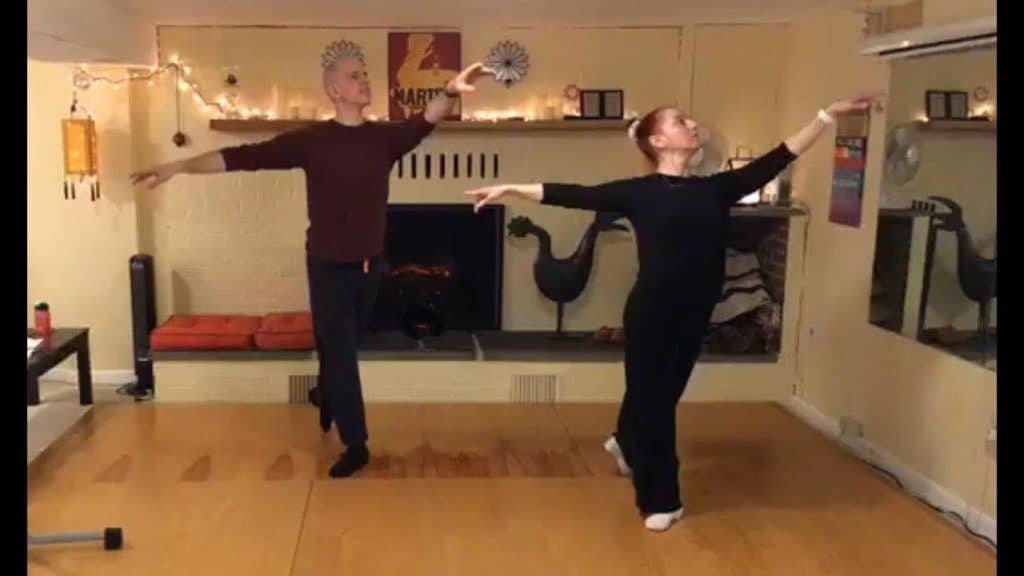
2020 has presented the world with many logistical challenges to overcome. If you are a dance teacher who can not currently teach in a studio you may be considering teaching dance classes online. Check out these 7 tips for hosting livestream classes to help you ease the transition into becoming an online dance teacher.
1. Your interactions with students will be different. This is a no brainer – of course it’ll be different!
New York swing dance teacher Stina Dallons explains how:
“It’s weird going from a teacher that is hands on. If I’m doing something and I look behind and I notice that someone else isn’t doing it correctly I can be like “No no no no, not that. Pick up your foot, put it down.” Now I have to wait for an emote. I’m waiting for a thumbs up or a heart.”
Feedback will likely come from students’ emotes or typed comments, which can be a challenge to monitor while you’re instructing. It’s a good idea to consider this factor when planning your lesson.
2. Time is relative. This one is simple but easy to forget at first. Not everyone who wants to take your online dance class lives in your region of the world. Always remember to specify the time zone when promoting your class!
3. Your livestream platform matters. Think about what is most important to you when you’re choosing a platform to teach on. Do you want your livestream to stay up until you take it down? Want access to your class to be for paying students only or open to everyone? Do you want to be able to see your students?
Consider your priorities and do a little research before that first lesson.
Know that you don’t have to stick to just one platform. Dance Break facilitator Jess Grippo uses multiple platforms.
“I open up a Zoom room. People can join if they want to see me and each other and allow me to see them. They join the Zoom room and then I broadcast the Zoom room to Facebook, but you can take part in it through Zoom if you want.”
4. Communicate requirements. How much floor space is needed for the class? Do students need a bar? A mirror? A partner? Is there a cost for the lesson? Are students required to download an app to participate in your online dance class?
Make sure to specify any important information before you begin the class.

5. Consider collaborations. Roger and Mané Plaut like to teach livestream ballet classes as a couple.
Here’s why:
“We find it’s easier to teach together for the online classes because there are so many different things to think about to make sure it’s all working properly. You have to make sure that the video feed is going out, that the sound quality is good, that the music can be heard, and you have to try to respond to people’s comments if they’re having problems.”
Additionally, during demonstrations, one faces the camera while the other faces away from it. Their students like to see both front and back views. People also enjoy watching the couple interact with each other during the lesson. It adds a little extra flavor to their dance class.
If you can’t physically collaborate with another dance teacher consider virtual collabs. Think about reaching out to other online instructors to cross-promote your online dance classes.
6. Test Your tools first. Fast internet connection and the right video equipment are both important factors for a successful livestream session. Roger and Mané experienced lag-time in the beginning but were able to fix the problem by upgrading their router. A good webcam or a smartphone with a high-quality camera is often essential for video.

Through trial and error, Lindy Hop and Balboa teacher Laura Keat found that her webcam was unable to keep up with her footwork. “Sometimes when we danced if we moved too fast the movement could be blurred whereas my iPhone camera is better for movement.”
Audio is a factor as well. If the mic on your camera isn’t picking up your voice well you might need to invest in an external microphone.
7. Promote your class in advance. Give people the opportunity to plan to take your dance class! Many teachers create a Facebook event page prior to the class and invite students, friends, and family. You can then share the event page to relevant Facebook groups. Some teachers even create their own Facebook group for their lessons. This can create a sense of community with your students or can be used as a medium to hype your classes. Got an email list? Send out a newsletter with your class dates!
There are many things to consider before teaching an online dance class, but there are some things you won’t know until you try! Planning is important but it’s okay to be flexible and change things as you learn.
For a little inspiration check out our Epic Online Dance Classes article.



